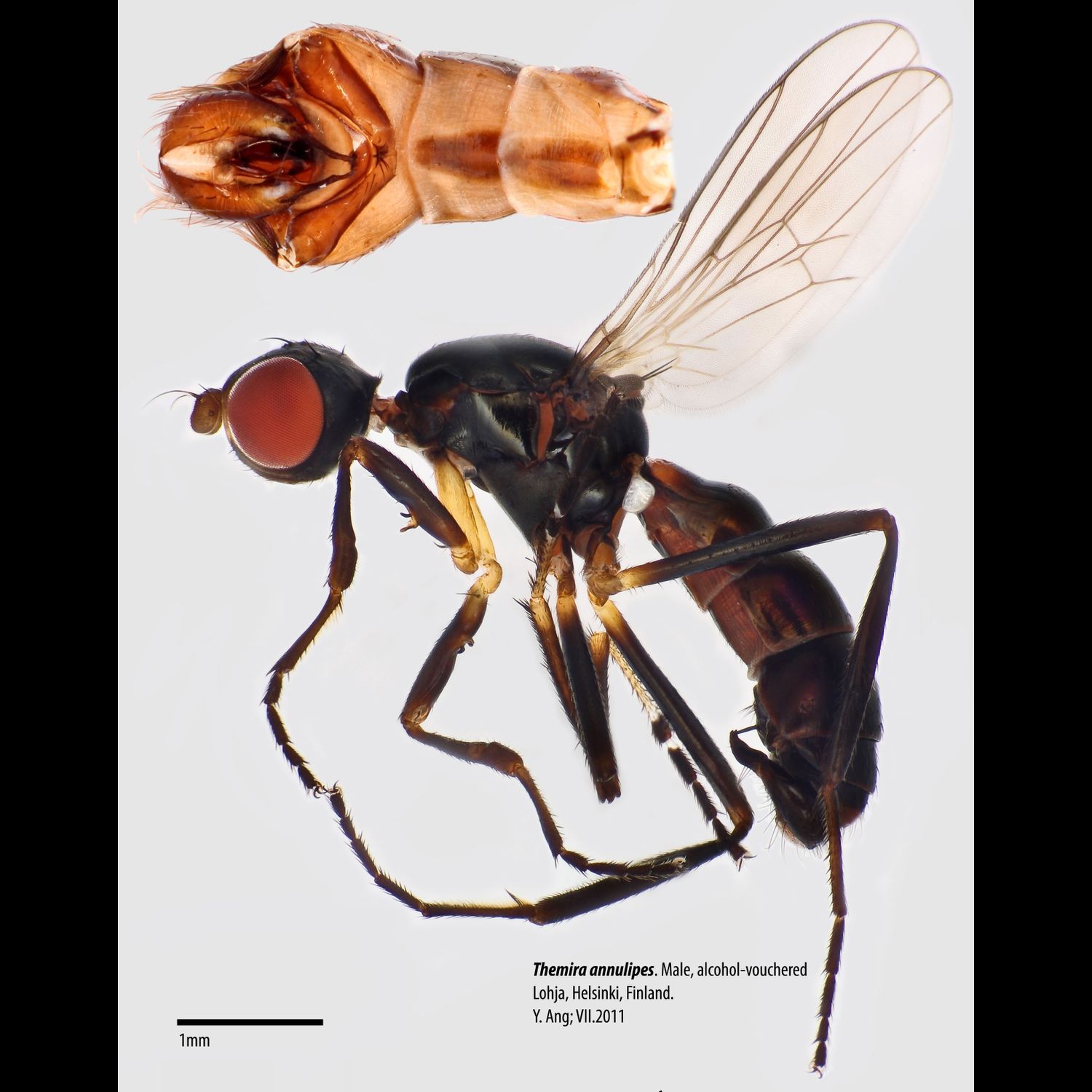

Male

Themira annulipes. Male alcohol-vouchered specimen.
Deposited at: Evolutionary Biology Laboratory, National University of Singapore (Singapore)

Diagnostic illustrations for adults
Adapted from:
Pont AC & Meier R (2002). The Sepsidae (Diptera) of Europe. Brill: 1-188.
Adult male recognised by the remarkable form and colour of the mid tarsomeres (Fig. 101). Females recognised by the absence of postpronotal setae, entirely pruinose katepisternum, and partly yellow legs; it is most similar to paludosa, but can be reliably distinguished by the characters given in the key.
Source:
Pont AC & Meier R (2002). The Sepsidae (Diptera) of Europe. Brill: 1-188.
Sepsidae: Sepsinae: "Lower sepsids": Themira (Enicita)
THEMIRA ANNULIPES Meigen 1826 (as Sepsis). Not Stated: Exact locality not stated. Lectotype ♂, by designation of Pont in Pont & Meier, 2002: 64, in Naturhistorisches Museum, Vienna, Austria.
brunicosa Robineau-Desvoidy 1830 (as Nemopoda). France: Saint-Sauveur. Holotype ♀ or Syntypes ♀♀, presumed destroyed.
varipes Meigen 1838 (as Nemopoda). Germany: Bavaria, Baiern. Holotype ♀, in Muséum National d’Histoire Naturelle, Paris, France.
marginata Hoffmeister 1844 (as Sepsis). Germany: not stated [GERMANY: Hessen]. Holotype ♂, not located and presumed destroyed.
crassiseta Duda 1926 (as Enicita). France: Chamonix. Lectotype ♀, by designation of Ozerov, 1997a: 479, in Museum für Naturkunde der Humboldt- Universität, Berlin, Germany.
nigra Duda 1926 (as Enicita). Unavailable name; citation of a Meigen MS name, in synonymy with Enicita nigra and Themira superba.
elegantipes Ouellet 1940 (as Enicita). Canada: Quebeck, comté Gaspé, Val d’Espoir. Holotype ♂, in Université de Montréal, Montreal, Canada.
Source:
Ozerov 2005, World Catalogue of the Family Sepsidae (Insecta: Diptera), Zoologicheskie issledovania 8.
Palaearctic (Asia): China, Kyrgyzstan, Mongolia, Russia (Altay, Amurskaya Oblast’, Chelyabinskaya Oblast’, Irkutskaya Oblast’, Krasnoyarskiy Kray, Novosibirskaya Oblast’, Primorskiy Kray, Sakha, Sakhalinskaya Oblast’, Tomskaya Oblast’, Tyumenskaya Oblast’), Uzbekistan.
Palaearctic (Europe): Austria, Belgium, Bulgaria, Czech Republic, Denmark, Estonia, Finland, France, Germany, UK, Greece, Hungary, Ireland, Italy, Latvia, Lithuania, Netherlands, Norway, Poland, Russia (Alania, Arkhangel’skaya Oblast’, Belgorodskaya Oblast’, Bryanskaya Oblast’, Ivanovskaya Oblast’, Leningradskaya Oblast’, Moskovskaya Oblast’, Pskovskaya Oblast’, Ryazanskaya Oblast’, Smolenskaya Oblast’), Romania, Slovakia, Spain, Sweden, Switzerland, Turkey, Ukraine, former Yugoslavia.
Nearctic: Canada (Alberta, British Columbia, New Hampshire, Nova Scotia, Ontario, Quebeck), USA (Alaska, Maine, New York, Ohio, Utah, Washington).
Source:
Ozerov 2005, World Catalogue of the Family Sepsidae (Insecta: Diptera), Zoologicheskie issledovania 8.